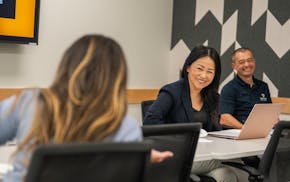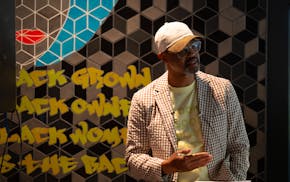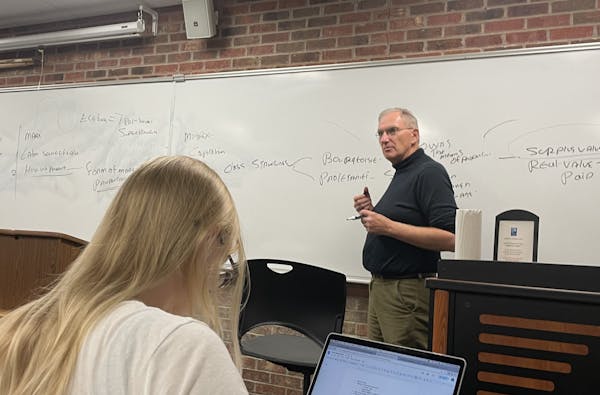Civic involvement by business owners and leaders in Minnesota communities looks strong — at least on the surface.
Dig deeper and you'll hear concerns about forces that have hurt many organizations — from churches to service clubs to affinity groups — that rely heavily on time and money from volunteers.
Leaders are seeing a loss of public-mindedness and a major change in habits: People just don't go out as much after becoming homebound in the pandemic.
Nonoko Sato, executive director of the Minnesota Council of Nonprofits, recently told me the quickest way to contribute to the civic good is simply to show up.
"It's not necessarily about money, though I do think that's important," Sato said. "It is as simple as going to see a show at the theater. If you look at arts organizations, people aren't coming back from staying home in the pandemic era."
A small but growing number of experts on governance and economics are also worried that an erosion of establishment forces is a reason people are unable to tackle hard problems.
"I have become concerned in recent years that the existing stock of social capital in Minnesota has become depleted, and I do not see significant efforts to replenish it," said Steve Young, executive director of the St. Paul-based Caux Round Table for Moral Capitalism.
"Social capital is when you come together and form a critical mass of will and ideas," he added. "It's that critical mass that allows you to go out and make a difference."
Most American cities benefited in the 20th century from groups of prominent business leaders who influenced other institutions such as school systems and arts groups for the greater good.
They weren't diverse — chiefly affluent white men — nor democratic, and they had the advantage of more rapid population and economic growth than exists today. Those groups got things done, however.
Their decline, essayist Thomas Edsall wrote in the New York Times last month, has been particularly hurtful in cities such as St. Louis, Baltimore and Cleveland. One of the researchers he cited, demographer Aaron Renn, wrote in Governing magazine in August that civic leadership culture in many cities has turned "diffuse, bureaucratic, highly risk-averse, and with limited capacity to address major challenges."
One reason for the change, Edsall wrote, is the wave of corporate acquisitions that reduced the number of "big anchor" companies in cities. That's where the Twin Cities and Minnesota look different.
This is still the home of three dozen companies exceeding $1 billion in annual revenue, along with thousands of smaller businesses that have all been influenced by a tradition of civic involvement.
"You're almost an outlier if you aren't participating and contributing," said Greg Cunningham, chief diversity officer at U.S. Bancorp. "We have much more inclusive leadership and voices at the table than we've ever had before."
He cited as an example the work that U.S. Bank and four other banks did to attract First Independence Bank, a Black-owned Detroit-based bank, to the market in 2021.
For decades, the Twin Cities business establishment revolved around the Dayton brothers, the Minneapolis Club and some big churches. In the 1960s, the Daytons gathered executives together to respond to riots in north Minneapolis. Control Data, then the region's high-tech giant, built a plant there.
In the 1990s, the Daytons directed one of their executives, Peter Hutchinson, to work with Minneapolis schools. He later became school superintendent and state finance commissioner.
Twenty years ago, those informal networks turned a bit more formal. Top executives formed the Itasca Group, a kind of think tank where the execs volunteered to work on regional problems. Last year, the group was restructured as a project within Greater MSP, which is a full-time organization formed by Itasca in 2011.
"It changes form. It changes people. But the spirit that all of us need to be committed and working together to create a vibrant community continues on," said Tim Welsh, who co-founded Itasca when he was a consultant in the Minneapolis office of McKinsey & Co. He is now vice chair of U.S. Bancorp and co-chairs Greater MSP.
Greater MSP staged a workshop last Wednesday on ways to attract more people to Minnesota. This week, the Minnesota Business Partnership hosts its annual dinner, bringing together political and business leaders.
Business organizations see community development as an effect of economic development. Nearly all of the approximately 50 projects at Greater MSP address the slowdown in the region's economic growth.
"There's economic development and there's community development and there's a relationship between the two," Peter Frosch, who has been CEO of Greater MSP since 2019, said. "It's different work typically done by different entities, but not to be understood as a choice."
The nexus is the nonprofit community, which has exploded in size over the last 30 years and historically counted on business for financial resources and governance help.
As businesses received government aid in the pandemic, so did nonprofits and the help lasted longer. Indeed, many are only now transitioning from that assistance.
"Without that sustained support, now these organizations are having to think about changing around their programming or sunsetting some of it," Sato said.
Some Minnesota nonprofits this spring got an infusion from the state government, which had a giant revenue surplus. Sato said many missed out, though, and the nonprofit council recently formed a working group to help organizations learn to seek government grants.
"We saw rural nonprofits, organizations serving communities of color and little tiny organizations miss the opportunity to be able to get both the [pandemic] relief funding as well as this current surplus," Sato said.
In all, it's a complicated picture that's different from a generation ago. Today, Minnesota's business groups are chiefly focused on new ideas for growth, which will yield the fuel government and nonprofits need to make living here better.
At least it's easy for you to make a difference: Get out. See a show. Visit a museum.

Ramstad: Gov. Walz, things are not getting done in Minnesota

Ramstad: AI is English-centric, but it's picking up Hmong quickly

Ramstad: Minneapolis' Camden neighborhood is rising. Houston White wants to keep it that way.

Ramstad: Minnesota's big businesses are in crisis with a common problem


